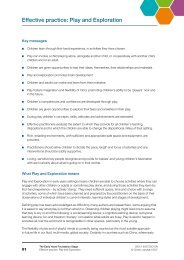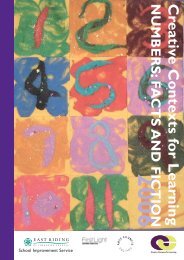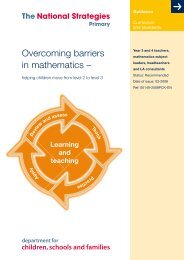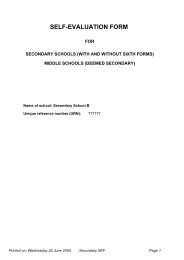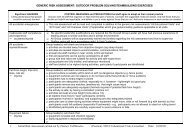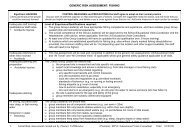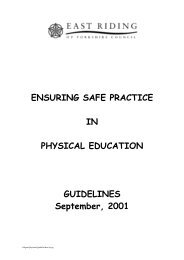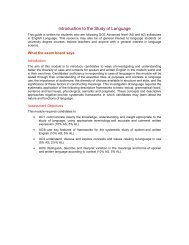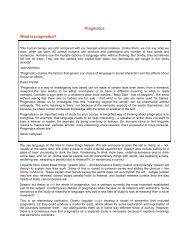Listening to Young Children - Northamptonshire County Council
Listening to Young Children - Northamptonshire County Council
Listening to Young Children - Northamptonshire County Council
Create successful ePaper yourself
Turn your PDF publications into a flip-book with our unique Google optimized e-Paper software.
Strategies <strong>to</strong> improve<br />
listening skills<br />
A reflective early year’s learning<br />
environment is not only conducive <strong>to</strong><br />
achievement, but it is also required by<br />
the EYPS and the EYFS. Standard 22<br />
of the requirements for Early Years<br />
Professional Status (EYPS) states that<br />
practitioners need <strong>to</strong> ‘give constructive<br />
and sensitive feedback <strong>to</strong> help children<br />
understand what they have achieved<br />
and think about what they need <strong>to</strong> do<br />
next and… <strong>to</strong> think about, evaluate<br />
and improve on their own<br />
performance.’ (CWDC, 2006, p10).<br />
As discussed earlier it is also a<br />
requirement of the Early Years<br />
Foundation Stage (EYFS), under<br />
Personal, Social and Emotional<br />
Development, that we help children <strong>to</strong><br />
‘know themselves and what they can<br />
do’ (DfES, 2007, p22).<br />
The EYFS Profile also highlights that<br />
‘the importance of involving children in<br />
the assessment process is <strong>to</strong> enable<br />
them <strong>to</strong> develop their ability <strong>to</strong> express<br />
preferences and make choices, begin<br />
<strong>to</strong> understand that their views are<br />
respected and develop as au<strong>to</strong>nomous<br />
learners’ (QCA, 2003, p103).<br />
How are children’s<br />
views sought?<br />
Different ways of listening<br />
<strong>to</strong> young children:<br />
• Visual observations of children,<br />
written notes and pho<strong>to</strong>graphs.<br />
• Use of camcorders <strong>to</strong> record<br />
children’s activities that can be<br />
shared in discussions.<br />
• Pho<strong>to</strong>graph books in book corners <strong>to</strong><br />
promote discussion.<br />
• <strong>Children</strong> taking pho<strong>to</strong>graphs of<br />
things they would like the new<br />
children <strong>to</strong> know about the setting.<br />
• Thinking tree – children can ‘pose’<br />
thoughts for adults <strong>to</strong> consider<br />
when planning.<br />
• Giving choice – e.g. Choice books<br />
that show range of equipment that is<br />
available but restricted by space <strong>to</strong><br />
display it all.<br />
• <strong>Listening</strong> can place any time, any<br />
place…<br />
• Sustained, shared conversations.<br />
• Giving children time, space, flexibility<br />
<strong>to</strong> make choices.<br />
• Involve children in the planning.<br />
• The environment needs <strong>to</strong> allow <strong>to</strong><br />
listening time, body language, eye<br />
contact. Further more, it is very<br />
important <strong>to</strong> create an environment<br />
that is conducive <strong>to</strong> listening and<br />
noticing e.g. keeping distractions <strong>to</strong><br />
a minimum - some children cannot<br />
concentrate fully if there is<br />
background noise such as a<br />
television, radio or computer games.<br />
Vary ways of asking children such as<br />
verbal questions, using cameras,<br />
questionnaires, ideas boxes etc.<br />
Some of these examples are further explored in the appendices (case studies)<br />
and in the subsequent sections of this <strong>to</strong>olkit.<br />
9



